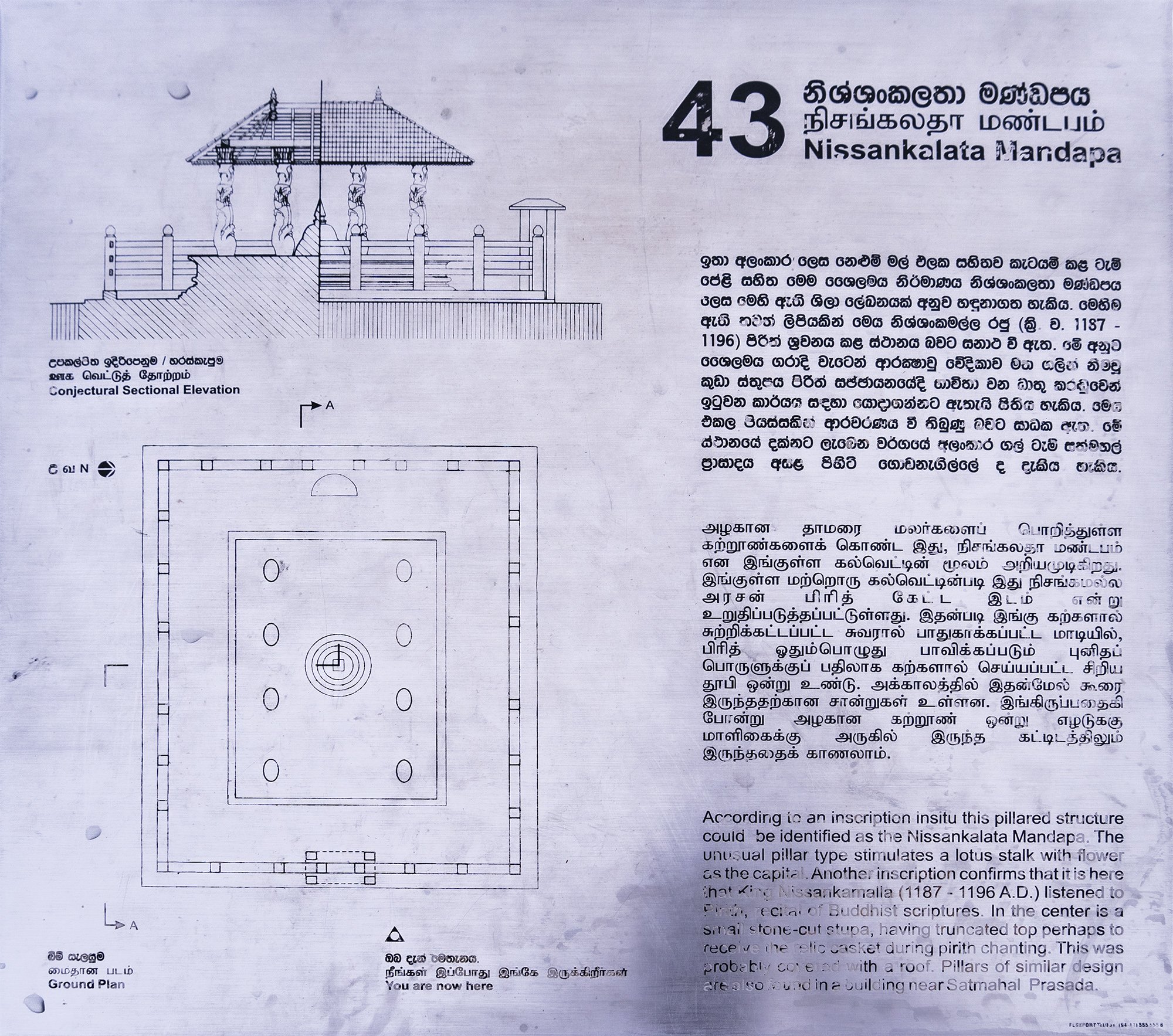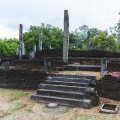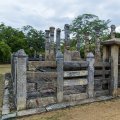Polonnaruwa (ancient city): photo 59
Photo 59 of 64 in Gallery: Polonnaruwa (ancient city)

Image title: Nissankalata Mandapa
Description of the photo
English text:
Nissankalata Mandapa (Mandapaya)—According to an inscription insitu this pillared structure could be identified as the Nissankalata Mandapa. The unusual pillar type stimulates a lotus stalk with flower as the capital. Another inscription confirms that it is here that King Nissankamalla (1187 - 1196 A.D.) listened to Pirith, recital of Buddhist scriptures. In the center is a smail stone-cut stupa, having truncated top perhaps to receive the relic casket during pirith chanting. This was probably covered with a roof. Pillars of similar design are also found in a building near Satmahal Prasada.
Note: Pirith or Pirit is the Sinhala word for paritta in Pali and refers to the chanting of “protective religious texts”.
Sinhalese text (not proofread):
නිශ්ශංකලතා මණ්ඩපය—ඉතා අලංකාර ලෙස නෙළුම් මල් ඵලක සහිතව කැටයම් කළ ටැම් පේළි සහිත මෙම ශෛලමය නිර්මාණය නිශ්ශංකලතා මණ්ඩපය ලෙස මෙහි ඇති ශිලා ලේඛනයක් අනුව හඳුනාගත හැකිය. මෙහිම ඇති තවත් ලිපියකින් මෙය නිශ්ශංකමල්ල රජු (ක්රි. ව. 1187 1196) පිරිත් ශ්රවනය කළ ස්ථානය බවට සනාථ වී ඇත. මේ අනුව ශෛලමය ගරාදි වැටෙන් ආරක්ෂාවු වේදිකාව මත ගලින් නිමවූ කුඩා ස්තූපය පිරිත් සජ්ජායනයේදි භාවිතා වන ධාතු කරඬුවෙන් ඉටුවන කාර්යය සඳහා යොදාගන්නට ඇතැයි පිතිය හැකිය. මෙය එකල පියස්සකින් ආරවරණය වී තිබුණු බවට සාධක ඇත. මේ ස්ථානයේ දක්නට ලැබෙන වර්ගයේ අලංකාර ගල් ටැම් සත්මහල් ප්රාසාදය අසළ පිහිටි ගොඩනැගිල්ලේ ද දැකිය හැකිය. -
Transcription (not proofread):
niśśaṅkalatā maṇḍapaya—itā alaṅkāra lesa neḷum mal phalaka sahitava kæṭayam kaḷa ṭæm pēḷi sahita mema śaĩlamaya nirmāṇaya niśśaṅkalatā maṇḍapaya lesa mehi æti śilā lēkhanayak anuva handunāgata hækiya. mehima æti tavat lipiyakin meya niśśaṅkamalla raju (kri. va. 1187 1196) pirit śravanaya kaḷa sthānaya bavaṭa sanātha vī æta. mē anuva śaĩlamaya garādi væṭen ārakṣāvu vēdikāva mata galin nimavū kuḍā stūpaya pirit sajjāyanayēdi bhāvitā vana dhātu karaṇḍuven iṭuvana kāryaya sandahā yodāgannaṭa ætæyi pitiya hækiya. meya ekala piyassakin āravaraṇaya vī tibuṇu bavaṭa sādhaka æta. mē sthānayē daknaṭa læbena vargayē alaṅkāra gal ṭæm satmahal prāsādaya asaḷa pihiṭi goḍanægillē da dækiya hækiya. -
Transcription (not proofread):
nishshankalata mandapaya—ita alankara lesa nelum mal phalaka sahitava katayam kala tam peli sahita mema shaĩlamaya nirmanaya nishshankalata mandapaya lesa mehi ati shila lekhanayak anuva handunagata hakiya. mehima ati tavat lipiyakin meya nishshankamalla raju (kri. va. 1187 1196) pirit shravanaya kala sthanaya bavata sanatha vi ata. me anuva shaĩlamaya garadi vaten arakshavu vedikava mata galin nimavu kuda stupaya pirit sajjayanayedi bhavita vana dhatu karanduven ituvana karyaya sandaha yodagannata atayi pitiya hakiya. meya ekala piyassakin aravaranaya vi tibunu bavata sadhaka ata. me sthanaye daknata labena vargaye alankara gal tam satmahal prasadaya asala pihiti godanagille da dakiya hakiya. -
Translation of Sinhalese text (automated translation):
Nishankalata Mandapa—This stone structure with rows of tams carved with exquisite lotus plaques can be identified as the Nishankalata Mandapa by an inscription here. Another letter here has confirmed that this is the place where King Nishshankamalla (1187-1196 AD) listened to Pirith. Thus, it is possible that the small stupa made of stone on the platform protected by the stone girder fence may have been used for the purpose of the relic casket used in the pirith decoration. There are evidences that this was covered by a stone at that time. Beautiful stones of the type seen at this site can also be seen in the adjacent building of the Tam Satmahal Prasad.
Tamil text (not proofread):
நிசங்கலதா மண்டபம்—அழகான தாமரை மலர்களைப் பொறித்துள்ள கற்றூண்களைக் கொண்ட இது, நிசங்கலதா மண்டபம் என இங்குள்ள கல்வெட்டின் மூலம் அறியமுடிகிறது. இங்குள்ள மற்றொரு கல்வெட்டின்படி இது நிசங்கமல்ல அரசன் பிரித் கேட்ட இடம் என்று உறுதிப்படுத்தப்பட்டுள்ளது. இதன்படி இங்கு கற்களால் சுற்றிக்கட்டப்பட்ட சுவரால் பாதுகாக்கப்பட்ட மாடியில், பிரித் ஓதும்பொழுது பாவிக்கப்படும் புனிதப் பொருளுக்குப் பதிலாக கற்களால் செய்யப்பட்ட சிறிய தூபி ஒன்று உண்டு. அக்காலத்தில் இதன்மேல் கூரை இருந்ததற்கான சான்றுகள் உள்ளன. இங்கிருப்பதைகி போன்று அழகான கற்றூண் ஒன்று எழடுக்கு மாளிகைக்கு அருகில் இருந்த கட்டிடத்திலும் இருந்ததைக் காணலாம்.
Transcription (not proofread):
nicaṅkalatā maṇṭapam—aḻakāṉa tāmarai malarkaḷaip poṟittuḷḷa kaṟṟūṇkaḷaik koṇṭa itu, nicaṅkalatā maṇṭapam eṉa iṅkuḷḷa kalveṭṭiṉ mūlam aṟiyamuṭikiṟatu. iṅkuḷḷa maṟṟoru kalveṭṭiṉpaṭi itu nicaṅkamalla aracaṉ pirit kēṭṭa iṭam eṉṟu uṟutippaṭuttappaṭṭuḷḷatu. itaṉpaṭi iṅku kaṟkaḷāl cuṟṟikkaṭṭappaṭṭa cuvarāl pātukākkappaṭṭa māṭiyil, pirit ōtumpoḻutu pāvikkappaṭum puṉitap poruḷukkup patilāka kaṟkaḷāl ceyyappaṭṭa ciṟiya tūpi oṉṟu uṇṭu. akkālattil itaṉmēl kūrai iruntataṟkāṉa cāṉṟukaḷ uḷḷaṉa. iṅkiruppataiki pōṉṟu aḻakāṉa kaṟṟūṇ oṉṟu eḻaṭukku māḷikaikku arukil irunta kaṭṭiṭattilum iruntataik kāṇalām.
Transcription (not proofread):
nisangalatha mandapam—azhagana thamarai malarkalaip porithulla karrunkalaig konda ithu, nisangalatha mandapam ena ingulla kalvettin mulam ariyamudigirathu. ingulla marroru kalvettinpadi ithu nisangamalla arasan pirith ketta idam enru uruthippaduthappattullathu. ithanpadi ingu karkalal surrikkattappatta suvaral pathugakkappatta madiyil, pirith othumbozhuthu pavikkappadum punithap porulukkup pathilaga karkalal seyyappatta siriya thupi onru undu. akkalathil ithanmel kurai irunthatharkana sanrugal ullana. ingiruppathaigi ponru azhagana karrun onru ezhadukku maligaikku arugil iruntha kattidathilum irunthathaig kanalam.
Translation of Tamil text (automated translation):
Nisangalatha Mandapam—It is known from the inscription here as Nisangalatha Mandapam, with pillars inlaid with beautiful lotus flowers. According to another inscription here, it is confirmed that this is the place where King Nisangamalla asked for Prith. Accordingly, on the floor protected by a wall surrounded by stones, there is a small obelisk made of stones in place of the sacred object used during the recitation of the Prith. There is evidence that it was roofed at that time. A beautiful pillar like the one here can be seen in the building near the Egeduku mansion.
Gallery information:
These photographs were taken at the Polonnaruwa archaeological site which preserve some of the monuments and religious structures of the ancient kingdom of Polonnaruwa (also Pulathisipura or Vijayarajapura) of Sri Lanka dating to the 10th century CE. Some of the important kings who reigned in this kingdom are King Vijayabahu I and his grandson, king Prakramabahu the Great. The city and it's architecture were influenced by various religious such as Hinduism in its early history, Shaivism and later Buddhism.
Photo details:
Date: 2023-08-31
Camera: SONY ILCE-6400
Exposure: 1/160
Aperture: f/4
ISO: 250
Focal length: 18mm
High resolution:
Download file
Size: 1.78 MB
Resolution: 2000 x 1767
© Photograph by Gabe Hiemstra.
License: CC BY-NC-ND 4.0

